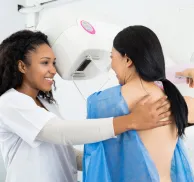DXA, which stands for Dual-Energy X-Ray Absorptiometry, is a special type of x-ray that measures bone mass and bone loss. Unlike ordinary x-rays, DXA scans can measure tiny reductions in bone density, providing a highly accurate picture of bone mass.
Although DXA is known for its use in measuring bone density, it is also used to measure body composition—the amount of bone, fat, muscle, and water in the body. Body composition is important because it can provide information about a person’s overall health and level of fitness.
DXA is the gold standard method of bone densitometry. It is fast, non-invasive, safe, and extremely accurate.
What Is a DXA Scan?
DXA scans use two x-ray beams with different energy levels to scan both bone mass and soft tissue. The bone imagery can be separated and used to detect bone loss and osteoporosis. What’s left over, the fat and muscle, can be used to monitor health and fitness in a variety of applications.
Although DXA can scan the whole body, specific areas are focused on depending on the reason for the scan. Physicians will specify regions of interest (ROIs), as needed. The hip, spine, and wrist are targeted for screening patients for osteoporosis since these areas are particularly susceptible to fracturing and represent both cortical and trabecular bone.
No matter which type of bone density scanner is being used, the procedure is basically the same for all. The patient lies down on the bed of the scanner, and a machine arm passes two x-ray beam intensities slowly over the body or over the specific region of interest. The DXA technologist is responsible for manipulating the machine to target the desired area(s).
DXA scanners are fast. With newer scanners, it takes less than a minute to do a specific region. A whole-body scan can be accomplished in three minutes. Older machines will take longer but are still fast compared to other procedures.
Once the scan is completed, a report is generated. The format of the report might vary somewhat depending on the type of scanner used, the specified ROIs, and the type of information that is needed. DXA can provide data that can be used in many applications, such as to measure the ratio of different types of fat, assess metabolism, calculate BMI, and diagnose osteoporosis and sarcopenia (loss of skeletal muscle mass). In general, though, reports will include the same basic elements: images, graphs, and numbers. Some scanners use color mapping, which generates a report that uses color to identify fat, muscle, and bone.
Because of the dual x-ray beam technology and the ability of DXA to use complex algorithms to make calculations, DXA measurements have high validity, precision, and accuracy. In fact, a DXA scan is so precise that one can tell whether a patient is left or right-handed based on the bone mineral density calculation. Most people have 7–9% more muscle in the hand they use for most activities. As for ambidextrous people—that could go either way!
Interestingly, the output of different types of scanners is often slightly different. For example, one type might shoot a little higher or lower. Because DXA is so precise, even slight changes in position can affect the results. It’s therefore important for a patient to be scanned on the same scanner when monitoring progress. Although there are conversion charts for some types of machines, the best way to avoid inconsistency is to stick with one machine.
DXA scans are noninvasive, painless, and fast, and they produce very low levels of radiation, so there is minimal exposure to both the patient and the technologist.
DXA vs DEXA
You may see the term “DEXA” used interchangeably with “DXA.” However, the former term is technically incorrect. DXA is pronounced “DEXA,” but the acronym stands for Dual X-ray Absorptiometry.
DXA for Bone Density
When we’re young, our body makes new bone faster than it breaks down old bone, and our bone density increases as we age. At about the age of 30, however, the process reverses and bone mass is lost faster than it's created. At that point, bone density naturally decreases over time, sometimes gradually and sometimes more rapidly. A person’s height decreases when they are older, sometimes by as much as several inches, because of this process. This phenomenon is especially pronounced in women.
Although bone loss is normal as we age, too much loss can lead to a disease called osteoporosis. This condition is characterized by low bone mass and structural deterioration of bone tissue. Osteoporosis causes bone fragility and increased susceptibility to fractures.
DXA is used to diagnose and monitor this condition. The test compares a patient’s bone mineral density (BMD) to that of a “young adult” at peak bone mass, as well as to that of a person in the same age range. Two scores are generated, which together are used to determine whether osteoporosis is present and how severe it is.
While DXA is used to diagnose osteoporosis, it can also be used to monitor it. People who are taking medication for osteoporosis often get DXA scans periodically to determine whether the medication is working. And since bone loss is the single most accurate predictor of increased fracture risk, monitoring the progression can help patients stay abreast of which areas of their bodies are more vulnerable.
DXA for Body Composition
Body composition, which is the total amount of bone, fat, muscle, and water in the body, is considered by many in the scientific community to be one of the most effective measures of body fat and overall health. Traditionally, body fat has been measured by calculating a person’s BMI, or body mass index. This is usually done using a formula that compares weight and height. Some handheld devices and calipers use bioelectrical impedance or skinfold measurements to determine BMI.
However, these methods are not as accurate, and BMI itself doesn’t provide any indication of the type and distribution of fat in the body. Understanding fat type and location is important because visceral fat (the fat located around your organs) has been linked to several diseases, including chronic inflammation and heart disease.
That’s where DXA comes in. Not only is DXA a much more accurate way to calculate BMI, but it also goes beyond measuring BMI to provide a total body picture. A DXA composition report provides a detailed analysis of body composition and can be tailored to focus on specific aspects of body composition.
Current Uses for DXA Body Composition
Although there are several specific applications of DXA (such as to measure metabolism, as mentioned previously), there are two general areas in which body composition DXA is currently being used:
- By physicians (and athletic trainers) to monitor overall fitness and health (in particular, helping patients who are dangerously obese or thin)
- By athletic trainers to improve an athlete’s performance
Overall Fitness and Health
In the past, physicians or trainers focused on overall body weight in determining a patient’s level of fitness and overall health. But weight loss alone does not paint a complete picture. The distribution and amount of fat vs muscle, as well as the type of fat, is what really determines a person’s health. For obese patients, the goal is not just to lose weight, but to reduce fat and build muscle. Overly thin patients need to increase body mass overall, not just fat.
That is why DXA is so useful for monitoring fitness and health. If an obese patient loses weight by only reducing body fat, they need to change their weight loss strategies—perhaps a different diet, exercise regimen, or overall lifestyle. A thin person who only gains fat needs to revise their method of gaining weight.
Athletic Performance
Although athletes need to be strong and fit overall, different sports and positions have different requirements. Some sports require strength in particular areas: A soccer player needs to have strong legs. A baseball player needs strong arms. A field goal kicker needs one particular leg to be strong. These athletes need to increase muscle mass in those parts of the body. On the other hand, sports such as running and cycling require endurance. These athletes need to increase lean muscle mass.
Uses of Body Composition in Athletics:
- Decrease fat
- Build mass in the right region
- Target specific muscles and areas of the body
- Detect muscle loss due to age or overtraining
- Track injury recovery
The beauty of DXA is that it can target areas of the body to assess and monitor fat and muscle mass in ways that will improve performance. Some sports teams and athletic training facilities actually have their own DXA scanner. Pro athletes use it frequently, as often as every month, to ensure their training is producing the desired results.
In addition, different sports may have different seasonal requirements, such as athletes that have to maintain standard body compositions at certain times of the year. For example, a linebacker might “bulk up” before the football season.
Benefits of DXA Body Comp for Athletes:
- Fast, safe, and non-invasive
- Can be done frequently to track progress
- Measures body composition by region (not just overall)
- Visualize muscle vs fat instead of just weight
- Examines Visceral Adipose Tissue (VAT) – a health risk factor
- Identifies body composition phenotypes for different sports or health risks
All in all, DXA is a good way for both physicians and trainers to ensure that, whatever the desired outcome, the method being used will help achieve it.
Training DXA Technologists
Looking to learn more about DXA and bone densitometry? Medical Technology Management Institute (MTMI) currently offers two DXA programs for radiologic technologists. Our Bone Densitometry Training Course is 2 days, entirely via webinar, prepares you for a certification exam, and provides 16 hours of Category A credits. We also offer a Registry Review in four webinar sessions that provide 4 Category A credits each. Both of these courses can be used to gain the 16 hours of structured education required to sit for the ARRT® bone densitometry examination.
MTMI programs are taught by experts with national reputations in their fields and cover every modality. Our cross-training courses, offered in classroom as well as via webinars, prepare you for registry exams and take your career to the next level. Check out our full catalog of programs or contact us with questions today!







